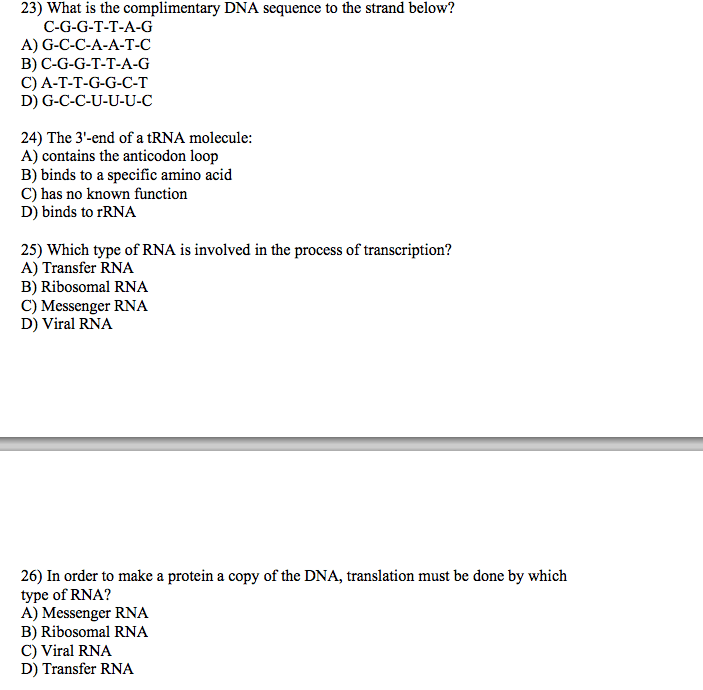BCEM 393 Lecture Notes - Lecture 17: Adenine, Consensus Sequence, Covalent Bond

RNA Processing
3 TYPES OF RNA MOLECULES PERFORM DIFFERENT BUT COOPERATIVE FUNCTIONS
-Messenger RNA (mRNA)
-Carries the genetic information copied form DNA in the form of a series of three-base
codes (codons)
-Each codon specifies a particular amino acid
-RNA polymerase II synthesizes mRNA
-Transfer RNA (tRNA)
-Key to deciphering the codons encoded in mRNA
-RNA polymerase III synthesizes tRNA
-Each type of amino acid has its own type of tRNA, which binds it and carrier it to the
growing end of a polypeptide chain
-The correct tRNA with its attached amino acid is selected at each step because each
specific tRNA molecule contains a three-base sequence (anticodon) that can base-pair
with its complementary codon in the mRNA
-Ribosomal RNA (rRNA)
-Associates with a set of proteins to form ribosomes (location of translation)
-These complex structures, which physically move along an mRNA molecule, catalyze the
assembly of amino acids into protein chains
-Bind tRNAs and various accessory molecules necessary for protein synthesis
-RNA polymerase I and III synthesize rRNA
-All 3 forms are transcribed into a pre-form and must be processed into their mature form to be
functional
RNA PROCESSING — PROKARYOTES VS. EUKARYOTES
-Prokaryotes:
-Ribosomes can start translating mRNA into protein during transcription
-Transcription and translation occur simultaneously
-Eukaryotes:
-rRNA and tRNA must be processed before they form ribosomes and transfer amino acids
to nascent polypeptide chains, respectively
-mRNA must be processed and transported outside the nucleus before translation can start
in the cytoplasm
RNA PROCESSING — RRNA — OVERVIEW
-RNA polymerase I transcription results in a single precursor = 45S
-45S encodes 3 RNA components of the ribosome: 18S, 28S, ad 5.8S rRNAs
-The 18S rRNA is the RNA component of the small ribosomal subunit (40S)
-The 28S and 5.8S rRNAs are two RNA components of the large ribosomal subunit (60S)
-The other RNA component of the large ribosomal subunit, the 5S rRNA, is transcribed by
RNA polymerase III as a separate transcript that is not 45S
-Cleavage of the pre-RNA 45S results in the 3 RNA components
-Mature rRNAs are then assembled into ribosomes (RNA and associated proteins) in the nu-
cleolus
find more resources at oneclass.com
find more resources at oneclass.com

-Not only is the precursor molecule (pre-RNA) is cleaved, but it is also modified with the con-
version of some uridines to pseudouridines and the addition of methyl groups to specific nu-
cleotides
-Modifications are directed by small nucleolar ribonucleoproteins (snoRNPs), which require
sequence complementarities between snoRNAs and the mature rRNAs
-Pre-rRNA contains external transcribed spacers (5’-ETS, 3’-ETS) at both ends as well as in-
ternal transcribed spacers (ITS1, ITS2)
-Internal transcribed
spaces need to be ex-
cised out to be left
with mature RNA
-Cleavages result in the
removal of transcribed
spacers yielding mature
18S, 5.8S, and 28S
rRNA
-Modifications
-Modifications include
methylation (by
methyltransferases)
and pseudouridines
(Psi synthase)
-Pseudouridines are
isomers of the nucleoside uridine in which the uracil is attached via a carbon-carbon in-
stead of a nitrogen-carbon glycosidic bond
-Isomerization allows for the different linkage between the base and the sugar in pseu-
douridine
-Role of modifications?
-The modifications are restricted to pre-rRNA sequences destined for the ribosome (ie. not
found in transcribed spacer regions
-This suggests that the modifications affect mature rRNA function
-In bacterial ribosomes, at least some of the modifications have been shown to confer
resistance to toxic antibiotics
-Affect mature rRNA stability, therefore making them not as susceptible to degradation
-But, the inhibition of methylation has been shown not to be critical for pre-rRNA matura-
tion
-Yeast cells lacking most of the snoRNAs grow normally, suggesting they (methylation)
are not essential
-The complete function of such modifications to pre-rRNA remain unclear
TRNA — GENERAL ROLE
-In mature tRNA, one end of the tRNA matches the genetic code in a three-nucleotide se-
quence called the anticodon
-The anticodon forms three complementary base pairs with a codon in mRNA during protein
biosynthesis
-On the other end of the tRNA is a covalent attachment to the amino acid that corresponds to
the anticodon sequence
find more resources at oneclass.com
find more resources at oneclass.com
Document Summary
3 types of rna molecules perform different but cooperative functions. Carries the genetic information copied form dna in the form of a series of three-base codes (codons) Each codon specifies a particular amino acid. Key to deciphering the codons encoded in mrna. Each type of amino acid has its own type of trna, which binds it and carrier it to the growing end of a polypeptide chain. The correct trna with its attached amino acid is selected at each step because each specific trna molecule contains a three-base sequence (anticodon) that can base-pair with its complementary codon in the mrna. Associates with a set of proteins to form ribosomes (location of translation) These complex structures, which physically move along an mrna molecule, catalyze the assembly of amino acids into protein chains. Bind trnas and various accessory molecules necessary for protein synthesis. Rna polymerase i and iii synthesize rrna.






